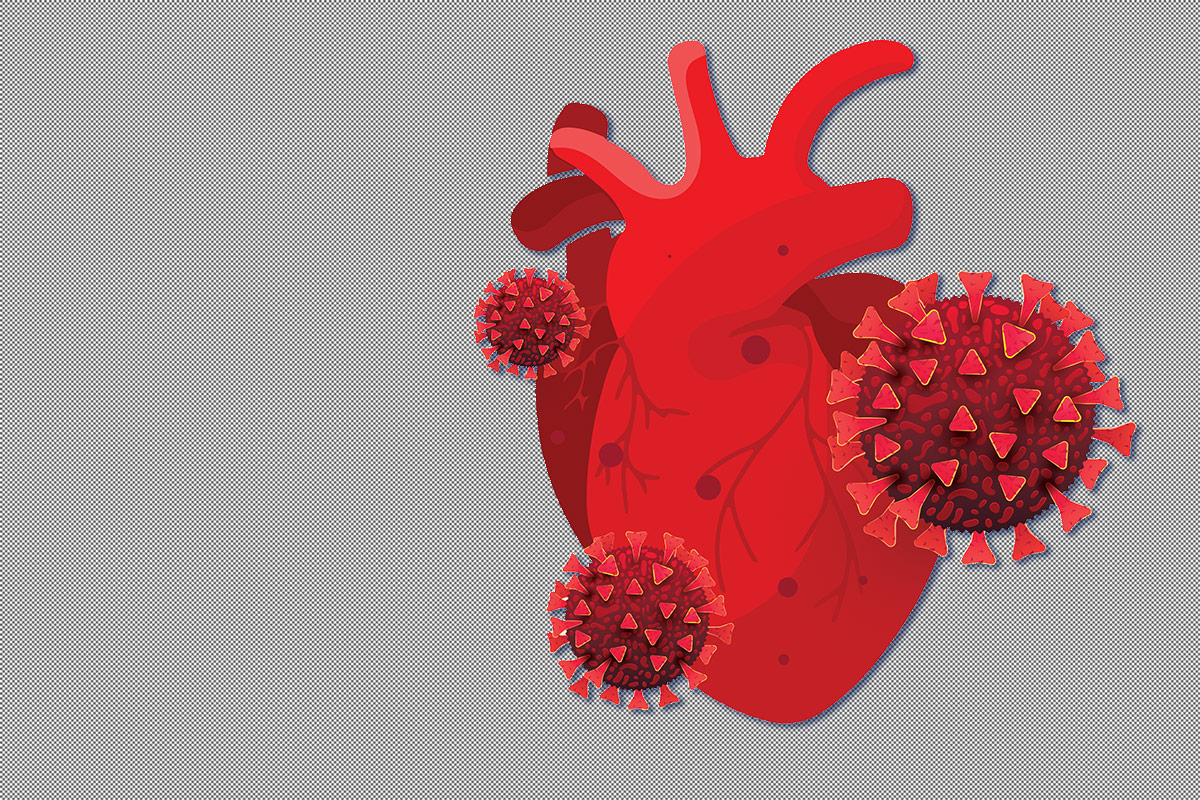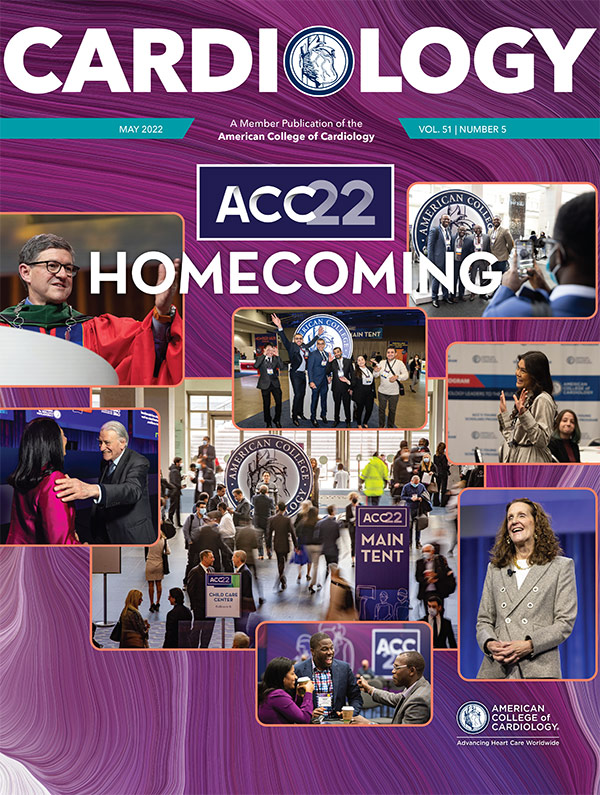Feature | Clinical Guidance on CV Consequences of COVID-19

A new Expert Consensus Decision Pathway released by the ACC addresses the evaluation and management of some of the more common cardiovascular sequelae in adults with COVID-19. Specifically, the document addresses myocarditis and other types of myocardial involvement, patient-centered approaches for long COVID, and guidance on resumption of exercise following COVID-19.
"The best means to diagnose and treat myocarditis and long COVID following SARS-CoV-2 infection continue to evolve," says Ty Gluckman, MD, MHA, FACC, co-chair of the Pathway. "This document attempts to provide key recommendations for how to evaluate and manage adults with these conditions, including guidance for safe return to play for both competitive and noncompetitive athletes."
Myocarditis
The document defines myocarditis as the presence of cardiac symptoms, an elevated cardiac troponin, and abnormal ECG, cardiac imaging and/or cardiac biopsy findings. The authors explain that although rare, myocarditis with COVID-19 is more commonly seen in men. Because myocarditis is associated with a higher risk of cardiac complications, the Pathway recommends a proactive management plan to care for these individuals.
For patients with mild or moderate forms of myocarditis, hospitalization is recommended to closely monitor for worsening symptoms, while undergoing follow-up testing and treatment. Patients with severe myocarditis should ideally be hospitalized at centers with expertise in advanced heart failure, mechanical circulatory support and other advanced therapies.
The Pathway also addresses myocarditis following COVID-19 mRNA vaccination, which is also rare. As of May 22, 2021, the U.S. Vaccine Adverse Event Reporting System noted rates of 40.6 cases per million after the second vaccine dose among male individuals aged 12-29 years and 2.4 cases per million among male individuals aged >30 years. Corresponding rates in female individuals were 4.2 and 1 cases per million, respectively. Although most cases of myocarditis following COVID-19 mRNA vaccination are mild, the authors note that it should be diagnosed and treated similarly to myocarditis following COVID-19 infection. Currently approved COVID-19 mRNA vaccines are highly effective, and the benefit-to-risk ratio is very favorable across all demographic groups evaluated thus far.
Long COVID
Post-acute sequelae of SARS-CoV-2 infection (PASC), a condition reported by up to 10-30% of infected individuals, is defined by a constellation of new, returning or persistent health problems experienced by individuals four or more weeks after COVID-19 infection. While individuals with this condition may experience wide-ranging symptoms, tachycardia, exercise intolerance, chest pain and shortness of breath represent some of the symptoms that draw increased attention to the cardiovascular system.
The writing committee proposed two terms to better understand potential etiologies for those with cardiovascular symptoms: PASC-CVD, or PASC-Cardiovascular Disease, refers to a broad group of cardiovascular conditions (including myocarditis) that manifest at least four weeks after COVID-19 infection.
PASC-CVS, or PASC-Cardiovascular Syndrome, includes a wide range of cardiovascular symptoms without objective evidence of cardiovascular disease following standard diagnostic testing.
In general, the Pathway recommends that patients with long COVID and cardiovascular symptoms undergo evaluation with laboratory tests, ECG, echocardiogram, ambulatory rhythm monitor and/or additional pulmonary testing based on the clinical presentation. Cardiology consultation is recommended for abnormal test results, with additional evaluation based on the suspected clinical condition (e.g., myocarditis). Because multiple factors likely underlie PASC-CVS, the document suggests that evaluation and management may be best driven by the predominant cardiovascular symptom(s).
For those with tachycardia and exercise intolerance, increased bedrest and/or a decline in physical activity may trigger cardiovascular deconditioning with progressive worsening of symptoms. The Pathway suggest that upright exercise (walking or jogging) should be replaced with recumbent or semi-recumbent exercise (rowing, swimming or cycling) to avoid worsening fatigue. Exercise intensity and duration should be low initially, with gradual increases in exercise duration over time. Transition back to upright exercise can be done as one's symptoms improve. Additional interventions (increased salt and fluid intake, elevation of the head during sleep, support stockings) and pharmacological treatments (beta-blockers) should be considered on a case-by-case basis.
Return to Play
Observation of cardiac injury among some patients hospitalized with COVID-19, coupled with uncertainty around cardiovascular sequelae after mild illness, fueled early apprehension regarding the safety of competitive sports for athletes recovering from COVID-19 infection. Subsequent data from large registries have demonstrated an overall low prevalence of clinical myocarditis, without a rise in the rate of adverse cardiac events. Based on this, updated guidance is provided with a practical, evidence-based framework to guide resumption of athletics and intense exercise training.
For athletes recovering from COVID-19 with ongoing cardiopulmonary symptoms or those requiring hospitalization with increased suspicion for cardiac involvement, the Pathway recommends performing further evaluation with triad testing – an ECG, measurement of cardiac troponin and an echocardiogram. For those with abnormal test results, further evaluation with cardiac MRI should be considered. Individuals diagnosed with clinical myocarditis should abstain from exercise for three to six months.
Cardiac testing is not recommended for asymptomatic individuals following COVID-19 infection. Individuals should abstain from training for three days to ensure that symptoms do not develop. For those with mild or moderate noncardiopulmonary symptoms (fever, lethargy, muscle aches), training may resume after symptom resolution. For those with remote infection (≥ three months) without ongoing cardiopulmonary symptoms, a gradual increase in exercise is recommended without the need for cardiac testing.
Based on the low prevalence of myocarditis observed in competitive athletes with COVID-19, the authors note these recommendations can be reasonably applied to high-school athletes (aged ≥14 years) along with adult recreational exercise enthusiasts. Future study is needed, however, to better understand how long cardiac abnormalities persist following COVID-19 infection and the role of exercise training in long COVID.
Clinical Topics: Arrhythmias and Clinical EP, Cardiovascular Care Team, COVID-19 Hub, Diabetes and Cardiometabolic Disease, Heart Failure and Cardiomyopathies, Prevention, Sports and Exercise Cardiology, SCD/Ventricular Arrhythmias, Atrial Fibrillation/Supraventricular Arrhythmias, Acute Heart Failure, Exercise, Sleep Apnea
Keywords: ACC Publications, Cardiology Magazine, COVID-19, COVID-19 Vaccines, Myocarditis, Cardiovascular Diseases, Swimming, Consensus, Bed Rest, Cardiovascular Deconditioning, Follow-Up Studies, Jogging, Jogging, Laboratories, Lethargy, Odds Ratio, Prevalence, Return to Sport, Uncertainty, Cardiovascular System, Cardiology, Electrocardiography, Fatigue, Vaccination, Dyspnea, Diagnostic Techniques and Procedures, Hospitalization, Patient-Centered Care, Referral and Consultation, Heart Failure, Tachycardia, Chest Pain, Registries, Troponin, Athletes, Schools, Walking, Writing, Biopsy, Muscles, Sleep, RNA, Messenger
< Back to Listings

